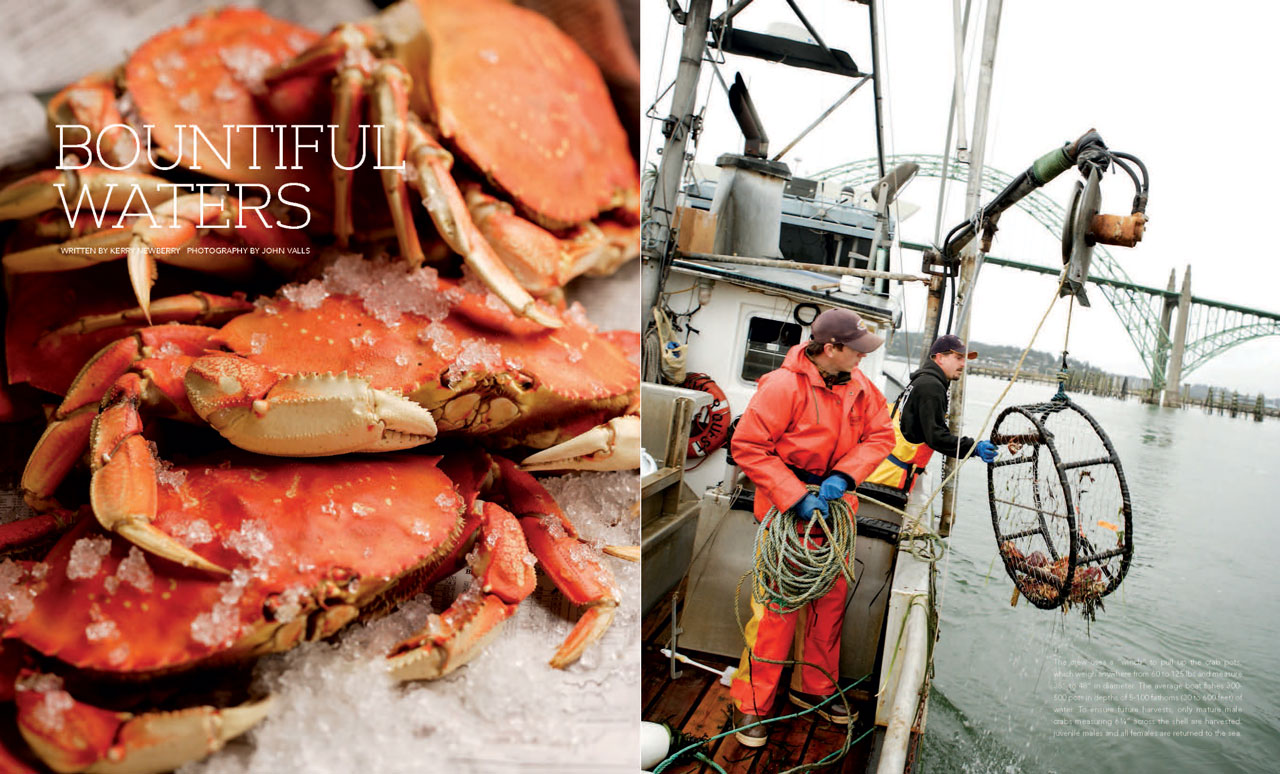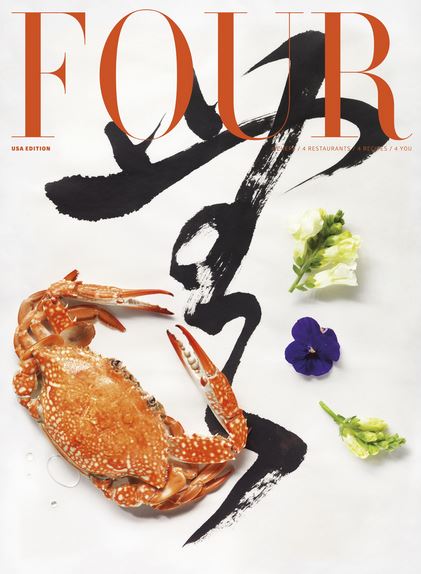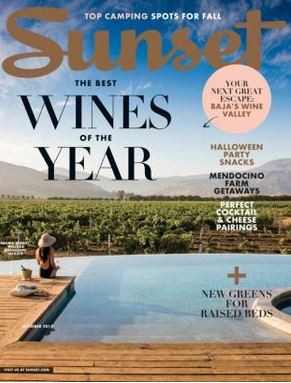Bountiful Waters: Newport’s Dungeness Crabbing Season

A silvery fog shrouds the Newport docks, and sweeps across the tips of towering pine trees. When a wind blows, the moored fishing boats slow dance in the blue-green Yaquina Bay. Stoic boats of handcrafted solid wood mingle with sleek shiny steel. Destiny and Heidi Sue, Summer Place, Seeker, Blue Fox and Orca, the names tattooed across each vessel, like terms of endearment.
It’s just before 8am on a Saturday morning and from afar the docks appear sleepy. Zoom in and a Bruce Springsteen ballad blasts from the F/V Orca, where three fishermen clad in construction orange waders prep for a halibut trip. The ruddy-faced captain directs his crew, currently fueled by the rock-n-roll.
Two boats away, seagulls swoop and squawk around a vessel returning from a successful Albacore tuna mission. A youthful fisher poses with a six-foot long slivery gray fish, nearing twenty pounds, still glistening from the sea. In Newport, from dawn to dusk, the bustling historic Bayfront, a working waterfront, is where all the action is.
Newport’s nautical heritage hails back to 1882 when the Bayfront was the economic backbone of the city, housing both a port for commercial fishing and the timber industry. Today, the Bayfront is one of two of the largest ports in Oregon and home to Oregon’s largest commercial fishing fleet. The Port of Newport also ranks in the top fifteen for fishery landings in the nation.
The fleet fishes year round for whatever is in season, ranging from halibut and herring to albacore, sablefish, salmon, sardines and shrimp. The most lucrative catch however, in terms of value, is Dungeness Crab, and Newport holds the crown for the “Dungeness Crab Capital of the World.”
The race for Dungeness crabs, the most valuable catch on the West Coast, kicks-off the first of December. When the days are short, dark and rainy. Out at sea, the wind and water is unpredictable and unruly. The working conditions demand a hardy spirit and a sense of adventure.
“The Dungeness Fishery is the most dangerous in the world,” says Cory Feldner, one of the crab fishermen based out of Newport, a fisher that relishes the thrill of the chase. Feldner is blond and baby-faced with a winsome smile.
He moved from North Dakota to fish with his uncle one summer, fell for the autonomous life at sea, and never left. Twenty-five years later, he’s now running the boat, after his uncle, Jeff Feldner, also a long-time commercial fisherman, stepped into a research position with Oregon Sea Grant.
Like many of the boats in Newport, the F/V Granville is a family affair. The seventy-year old, 45-foot vessel is crafted of solid wood, an increasing rarity among fishing boats today. Newport is home to one of the last working wooden boat fleets, works of art from a bygone era.
“They like to call it the deadliest catch up in Alaska,” Feldner continues, “but it’s really not, it’s more dangerous here.” Every year, an average of one or two fishermen lose their lives at sea.
In addition to the winter weather, the risk is when boats are crossing the Yaquina Bay bar—the shallowest area before heading out to sea. “You don’t want Hawaii Five-O’s coming on your boat,” says Feldner. “Water is powerful, it can bend steel and turn wood into toothpicks.”
Dungeness Crab starts as a derby fishery, come the first of December, the race is on. “You get them while you can, as fast as you can,” says Jeff Feldner, “It’s very important to be out there the first day.”
Which means even if the weather turns, once the big boats head out, small boats will follow, because the pressure is on. There are only so many crabs, and the majority of the commodity crustaceans are caught in the first two weeks of the season.
“Production drops about a third every time you run,” says Jeff. “In a bad year you might get half your year out of the first pick and the numbers go down every time you head out,” he adds.
The first week of crabbing, the boats often run back-to-back trips, returning only to unload and maybe sleep for a few hours. Feldner and his two-man crew on the F/V Granville work with 300 pots and land around 150,000-200,000 pounds of crab a year.
His boat holds about 8000 pounds of crab when it’s full. In comparison, the big boats that race pots until they are full can hold 50-60,000 pounds of crabs each trip. During peak crabbing season, Feldner and his crew are on the water by 5am, depending on the tides, and return by 11pm each night.
Each boat has a different brightly colored buoy that marks their crab pots and different lengths of line depending on where they drop them ranging from 30 to 600 feet deep. As Feldman drives the boat, his two-man crew uses a winch to haul each 100-pound crab pot up through the water.
Once on deck, the crew sorts the male and female crabs, re-baits the pot and tosses it overboard before the boat coasts up to the next buoy, which is about a football field away. “Just like connect the dots,” says Feldner. But at high-speed. Each pot takes two minutes tops and the process will be repeated up to 300 times in one day.
Despite the derby-style competition in commercial crabbing, comraderie still perseveres. Although a fisherman does not readily divulge where their crab pots are, we all pretty much know where other keeps their crab pots, says Feldner. “Whoever finds the fish, the other guys go there,” says Feldner. If you are getting a good catch, the secret won’t last long.
“That’s why you work in groups.” Most of the boats fish in packs, especially if they are fishing halibut or salmon solo. “If three or four guys head out alone on boats, they know where each other is and they pay attention to each other, so you are never really alone.”
The fisherman, in literature and lore, is often a romanticized character–an old salt with a cowboy spirit and a sea-soaked soul. In reality, commercial fishing is a hard life and a serious business, one that is in constant change as fisheries battle depleting resources, politics and the shifting economy.
“I always think it means something,” adds Feldman, when asked why he fishes. “It’s feeding people.”
Captain Bob, as he is affectionately called around the docks, mans the 51-foot F/V My Less, a boat built in 1975 during the war efforts. For him, fishing is a lifestyle, not just a business.
“I try to put as many days at sea as I can,” he says.
Andy makes every trip with me, he adds, gesturing across the boat. Andy is a fluffy white Shih Tzu nestled near a pile of rope. Yes, an uncommon boat dog. “He looks like a snazzy dog until he gets a little bit of fish on him,” says Kemp.
The ocean captivated Kemp at an early age. “I was five years old when my father built a small skiff and from there we would go out on a port and fish,” he says. At that point he was forever smitten with the sea.
“My work is my play,” he says. You know that tune, he asks? In a sort of spoken word he repeats the lyrics by musician Bob Franke: “What can you do with your days but work & hope. Let your dreams bind your work to your play.”
Kemp crabs with a 300 pot-permit for boat, which is considered a medium sized operation. He prefers crabbing a few weeks after the season starts. “The big boats leave after first few days of crabs and the smaller boats thrive,” he says. Volume goes down, and the price goes up.
“The Dungeness crab is cool fishery management wise because there is a big portion of it that takes care of itself,” says Kemp. A state-managed fishery, Oregon’s Dungeness crab is regulated by size, sex and season, only males meeting a minimum size standard (at least 6 ¼ inches across the back shell) are harvested.
Smaller males and all females are returned to the water to ensure healthy stocks for the future. “That’s the beauty of not over-harvesting,” says Kemp. Oregon’s strict targeted harvesting results in little or no “by-catch” mortality, another reason the fishery continues to make the “green light” category in guides such as the Monterey Bay Aquarium Sea Watch.
In 2010, the Oregon Dungeness Crab fishery earned Marine Stewardship Council (MSC) certification, one of only three crab fisheries in the world to receive MSC certification, and the only one of five West Coast Dungeness fisheries with the sustainability certification.
MSC is a global, independent organization that has developed the world’s leading environmental standard for certifying sustainable and well-managed wild-capture fisheries. “MSC is educating the fish eating public and having them become more aware of why fish costs what it does when it comes from here,” says Kemp.
As a fisherman that likes to spin a yarn, Kemp is interested in developing direct market sales with the community. “I think it’s very important that the public get a chance to talk to fishermen,” he says. One of the main reasons visitors head to Newport is to see a working waterfront. “If the public sees who I am and how I fish, I believe that leads to education,” says Kemp. “My passion is to put an identity, a face on who caught what.”

Portrait of Portland | Winter
Click here to read on the Portrait of Portland website https://www.portraitmagazine.com/bountiful-waters.





